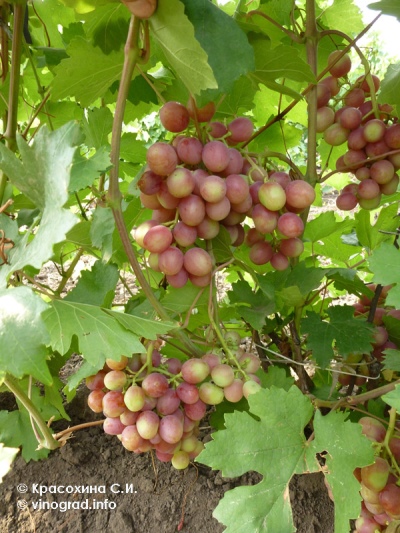
- Authors: Krainov V.N., Novocherkassk, Russia
- Appointment: dining room
- Berry color: pink
- Taste: nutmeg
- Ripening period: early
- Ripening period, days: 110-115
- Frost resistance, ° C: -23
- Name synonyms: Gourmet 1-12, Tenderness
- Bunch weight, g: 500-800
- Flower type: functionally female
Those who want to have a vineyard on their site should take a closer look at the Gourmet Early variety. It can be cultivated in many regions of the country.
Breeding history
The variety was relatively recently bred by an amateur breeder by the name of Krainov. It appeared in the register of our country in 2006. Official recognition had to wait for 10 years. People's love came immediately.
It was possible to get the variety after crossing the Talisman and Radiant Kishmish.
Its original name is Novocherkassk red. So he was known at the very beginning, because he was bred in this city.
Geography of distribution
The prospect for cultivation was noted in the south of the country. There are large vineyards with Gourmet Early in Moldova and Ukraine.
Description
Gourmet Early is classified as a vigorous plant. In one season, the vine ripens by 2/3.
To get a good harvest, professionals advise fan-pruning the plant, or growing it on a trellis in one row.
The leaves are medium in size with five distinct lobes. Their color is rich green.
Appointment
Gourmet Early is a table grape variety.
Ripening period
From the beginning of the growing season to the collection of berries, 110-115 days pass. According to the modern filter, these are early ripening grapes.
Bunches
The bunches form a cylindrical-conical shape. If we talk about the density of berries on them, then it is average. The weight of one bunch under ideal growing conditions reaches 500-800 g.
Peeling is observed, but it is insignificant.
Berries
The grapes have an attractive pink color. On the table, such a treat looks dignified.
Sugar in fruits contains up to 190 g / dm³.
The grapes are valued for their juicy and moderately fleshy pulp. Each berry is oval in shape and can weigh 7-9 grams.
In size, these are large fruits from 25x22 to 27x23 mm.
Taste
Unique nutmeg flavor.
Yield
Gourmet Early is a high-yielding plant that shows stability in fruiting. One can collect 15-20 kilograms of fruit. It is about 200 quintals per hectare.


Growing features
The flowers on the bush are functionally feminine, and this should be taken into account. The variety loves warmth, hence the need for careful selection of the place. In the shade, such grapes will grow poorly, the berries will begin to shrink.
It is best to choose black soil or loam for planting. With a high acidity coefficient, lime is added to the soil. The proportion is 3 kilograms per 1 cubic meter.
Landing
The best time for planting seedlings in open ground is April-May. It is important that the air has warmed up to + 12 ... 15 degrees by this time. If there is a possibility of sudden frosts, then the seedlings must be covered until the threat passes.
For planting planting material, it is advised to choose a sunny, windless place. Groundwater should be far from the ground surface. If this condition is not met, then there is a high probability of the appearance of root rot.

Pollination
Pollination is necessary, so the variety is planted close to grape bushes with male or bisexual flowers.
Pruning
Fruiting vines are pruned in the spring. 6-8 eyes are left on them. There should be 30-35 of them per bush.
In the same period, dead and damaged shoots are removed. In the fall, stepchildren and shoots that have not matured are removed.

Watering
When the seedling is young, it must be watered every week. After the procedure carried out, the soil is loosened and mulched obligatory. So it is possible not only to retain moisture, but also to prevent weeds from germinating.
Adult bushes are watered only 4 times per season:
when the buds open;
before flowering;
when the ovaries are formed;
after picking ripe bunches.
Watering is carried out not at the root, but in specially formed furrows. The norm is 60 liters of liquid, always warm.
It is best when drip irrigation is organized in the vineyard. It helps to maintain the required moisture level.


Top dressing
You can fertilize Gourmet Early with mineral or organic additives. It is worth falling asleep for the first time even when planting, they will last for several years while the plant takes root.
Phosphorus and potassium are added before flowering, after which it is necessary to add manganese, zinc and iron to the soil.
Manure and bird droppings are best used in the fall.
Frost resistance and the need for shelter
Frost resistance at the level of - 23 degrees. Shelter is necessary for the safety of the vine.

Diseases and pests
Diseases such as gray rot, mildew and powdery mildew are not terrible for Gourmet Early. But only under proper conditions of maintenance. If the humidity level is high, then there is a chance of infection.
As a prophylaxis, sulfur, Bordeaux liquid or one of the fungicides is used. Spraying is carried out in early spring. It also helps with anthracnose, which causes the shoots to dry out.
Infection with a tick is possible, insecticides or acaricides will help from it:
Actellik;
"Fosbecid";
"Neoron";
Apollo.
To protect against wasps and birds, each bunch needs to be covered with a dense net.

If the grapes are exposed to any disease or insect, this is always reflected in its appearance.
Storage
Berries tolerate long-term transportation. Their shelf life is up to six months.











































































